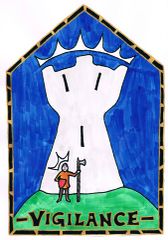Vigilance
mNo edit summary |
|||
| (19 intermediate revisions by 7 users not shown) | |||
| Line 1: | Line 1: | ||
{{CaptionedImage|file=ChildPrimer6.jpg|width=168|height=240|align=left|caption=From ''A Children's Primer of the Way''}} | {{CaptionedImage|file=ChildPrimer6.jpg|width=168|height=240|align=left|caption=From ''A Children's Primer of the Way''}} | ||
==The Path of Vigilance== | ==The Path of Vigilance== | ||
<!--fix--> | |||
The Virtue of Vigilance is popular amongst those charged with ensuring the safety of things precious; from the inquisitor who seeks out treacherous cultists, to the scrivener who | The Virtue of Vigilance is popular amongst those charged with ensuring the safety of things precious; from the inquisitor who seeks out treacherous cultists, to the scrivener who scrutinises their dhomiro’s records against fraud and theft, to the shepherds in the fields. The threats to the Empire and its citizens are many and varied and all must be prepared for, guarded against and actively opposed lest they tear down civilisation. Not all threats carry arms like the barbarians; some come with smiles and lies, like false-faced eternals, or even lie in the hearts of weak citizens. Through diligence, detail, and dedication in all things does one person’s Vigilance safeguard another from harm. | ||
===Guidance on the Path=== | ===Guidance on the Path=== | ||
Through meditation on the [[auras of Vigilance]], and by | Through meditation on the [[auras of Vigilance]], and by studying the lives of paragons and exemplars, the priests of the Way have gleaned insight into the heart of the virtue and how best to pursue it. There are collections of parables, tales, sayings and teachings that distil this for Imperial citizens to learn from. The following are a handful of teachings and sayings deemed to be essential to understanding the path: | ||
* Seek out the poison in your neighbour’s fields, lest your own crops be blighted. | * Seek out the poison in your neighbour’s fields, lest your own crops be blighted. | ||
| Line 14: | Line 14: | ||
==Paragons and Exemplars== | ==Paragons and Exemplars== | ||
Attempts to catalogue | Attempts to catalogue paragons and exemplars of Vigilance have met with mixed success. In some cases, the disaster they prevent or the catastrophe that goes averted results in their heroism going unsung. More notable are those who publicly expose traitors, infiltrators, and black-hearted villains. Recognised [[paragons and exemplars]] of Vigilance include: | ||
* The legendary | * The legendary paragon known as [[The Sentinel]], who is credited with building many ancient towers and fortresses that still stand today. | ||
* The | * The exemplar [[Berechiah]] who exemplifies the often unpopular idea that the vigilant should be prepared to do whatever is necessary to protect their people from outside threats. | ||
==Symbols of Vigilance== | |||
<onlyinclude> | |||
{{CaptionedImage|file=Vigilance_speed_your_path.jpeg|width=500|align=right|caption=The Lantern lights the path of the Virtuous through the Labyrinth.}} | |||
The '''tower''' is a common symbol of Vigilance, representing the ancient works of [[the Sentinel]]. The watchtower allows one to see great distances and prepare for coming threats, while a fortified tower or a '''castle''' allow one to protect that which is precious. Along similar lines, other tools of warding and warning are common symbols of the path, especially the '''bell''', the '''barred gate''', and the '''beacon'''. Priests and pilgrims of the Path of Vigilance will often carry a bell or whistle for precisely the purpose of alerting others to danger they have identified. A '''lantern''' is another popular symbol of Vigilance, as is the '''candle''' - both can be used to provide aid in dark places and to signal warnings to others. | |||
Mystically inclined [[Urizen]] favour the '''unblinking eye''' (an eye without lids). The eye has a great deal of [[Urizen_hearth_magic#The eye|hearth magic]] significance, and is often painted onto surfaces such as gates, doors, and the base of [[Urizen_culture_and_customs#The_Heliopticon|heliopticon]] towers as a reminder of the need to stay alert. During their Spring festival, they represent Vigilance with green flowers or sometimes wreaths of green leaves. The image of the unblinking eye can also be seen in the '''basilisk''', a common symbol for unsleeping Vigilance among the [[Highguard|Highborn]]. | |||
In [[Varushka]], eyes or grim faces are often carved into lintels or trees to keep watch over a vale; there are several stories of warnings being delivered in dreams to those who sleep in a house guarded by these peculiar icons. A similar role is played by the '''scarecrow''' (and to a degree the traditional [[The_Marches_hearth_magic#Poppets|poppet]]) in [[the Marches]]. | |||
The '''spear''' also stands as a symbol of Vigilance, especially among the [[Navarr]] where it has strong connotations of protecting against outside threats. | |||
Among the people of [[Wintermark]] Vigilance is represented by the loud '''jay''' and by the '''goose'''. The goose is also used as a symbol of the virtue in [[Varushka]], alongside the wise '''spider'''. The spider also serves as a symbol of Vigilance among some covert [[sect|sects]] in [[Urizen]], specifically as the [[astronomancy|astronomantic]] constellation of the [[The_Spider_and_The_Web#The_Spider|same name]]. The law of the Spider - ''things are watched by a hidden eye'' - is both a statement of the need to be constantly alert for danger and a reminder that others are always watching. Some magicians use the [[Runes|rune]] of [[Ophis|Revelation]], '''Ophis''', as a symbol of vigilance. | |||
The | </onlyinclude> | ||
==Further Reading== | ==Further Reading== | ||
Latest revision as of 14:28, 13 July 2025
The Path of Vigilance
The Virtue of Vigilance is popular amongst those charged with ensuring the safety of things precious; from the inquisitor who seeks out treacherous cultists, to the scrivener who scrutinises their dhomiro’s records against fraud and theft, to the shepherds in the fields. The threats to the Empire and its citizens are many and varied and all must be prepared for, guarded against and actively opposed lest they tear down civilisation. Not all threats carry arms like the barbarians; some come with smiles and lies, like false-faced eternals, or even lie in the hearts of weak citizens. Through diligence, detail, and dedication in all things does one person’s Vigilance safeguard another from harm.
Guidance on the Path
Through meditation on the auras of Vigilance, and by studying the lives of paragons and exemplars, the priests of the Way have gleaned insight into the heart of the virtue and how best to pursue it. There are collections of parables, tales, sayings and teachings that distil this for Imperial citizens to learn from. The following are a handful of teachings and sayings deemed to be essential to understanding the path:
- Seek out the poison in your neighbour’s fields, lest your own crops be blighted.
- Be alert to all dangers; within and without.
- Seek out falsehood and expose the truth.
- Prepare for malice, yet thwart malice before it strikes against you.
- Despise that which threatens what you watch over, whether by malice, lies, folly or carelessness.
Paragons and Exemplars
Attempts to catalogue paragons and exemplars of Vigilance have met with mixed success. In some cases, the disaster they prevent or the catastrophe that goes averted results in their heroism going unsung. More notable are those who publicly expose traitors, infiltrators, and black-hearted villains. Recognised paragons and exemplars of Vigilance include:
- The legendary paragon known as The Sentinel, who is credited with building many ancient towers and fortresses that still stand today.
- The exemplar Berechiah who exemplifies the often unpopular idea that the vigilant should be prepared to do whatever is necessary to protect their people from outside threats.
Symbols of Vigilance
The tower is a common symbol of Vigilance, representing the ancient works of the Sentinel. The watchtower allows one to see great distances and prepare for coming threats, while a fortified tower or a castle allow one to protect that which is precious. Along similar lines, other tools of warding and warning are common symbols of the path, especially the bell, the barred gate, and the beacon. Priests and pilgrims of the Path of Vigilance will often carry a bell or whistle for precisely the purpose of alerting others to danger they have identified. A lantern is another popular symbol of Vigilance, as is the candle - both can be used to provide aid in dark places and to signal warnings to others.
Mystically inclined Urizen favour the unblinking eye (an eye without lids). The eye has a great deal of hearth magic significance, and is often painted onto surfaces such as gates, doors, and the base of heliopticon towers as a reminder of the need to stay alert. During their Spring festival, they represent Vigilance with green flowers or sometimes wreaths of green leaves. The image of the unblinking eye can also be seen in the basilisk, a common symbol for unsleeping Vigilance among the Highborn.
In Varushka, eyes or grim faces are often carved into lintels or trees to keep watch over a vale; there are several stories of warnings being delivered in dreams to those who sleep in a house guarded by these peculiar icons. A similar role is played by the scarecrow (and to a degree the traditional poppet) in the Marches.
The spear also stands as a symbol of Vigilance, especially among the Navarr where it has strong connotations of protecting against outside threats.
Among the people of Wintermark Vigilance is represented by the loud jay and by the goose. The goose is also used as a symbol of the virtue in Varushka, alongside the wise spider. The spider also serves as a symbol of Vigilance among some covert sects in Urizen, specifically as the astronomantic constellation of the same name. The law of the Spider - things are watched by a hidden eye - is both a statement of the need to be constantly alert for danger and a reminder that others are always watching. Some magicians use the rune of Revelation, Ophis, as a symbol of vigilance.
Further Reading
- You can learn about the various spiritual roleplaying effects created by priests dedicated to Vigilance here.
- You can learn about the skills that priests can use to safeguard the virtue of Vigilance here.

